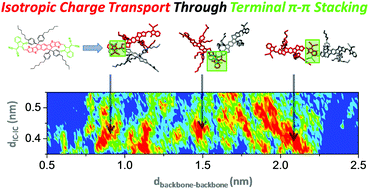Terminal π–π stacking determines three-dimensional molecular packing and isotropic charge transport in an A–π–A electron acceptor for non-fullerene organic solar cells†
Abstract
In recent years, great progress has been achieved in the field of non-fullerene organic solar cells. In particular, the power conversion efficiencies for the photovoltaic devices based on A–π–A fused-ring electron acceptors, e.g. ITIC, can catch up with or even surpass the fullerene-based ones. However, the detailed molecular packing structures and charge transport properties of these acceptors are rarely studied and still unclear, which has become the major obstacle for rational molecular design to further improve the photovoltaic performance. Here, we have unravelled the intermolecular arrangements in the ITIC film via atomistic molecular dynamics simulations. The simulated results point to that three-dimensional molecular packing is formed in the ITIC film through local intermolecular π–π stacking between the terminal acceptor units. In sharp contrast, the ITIC crystal grown by the slow solvent vapor diffusion approach exhibits a one-dimensional edge-to-face stacking structure. Consequently, excellent isotropic electron mobilities along three dimensions are found for the film and unprecedentedly, the overall mobility is even higher than that of the crystal. Our work suggests that judicious modulation of the terminal acceptor unit to increase local intermolecular π–π interaction would be an effective way to improve the electron mobilities and photovoltaic performance of the A–π–A electron acceptors.



 Please wait while we load your content...
Please wait while we load your content...